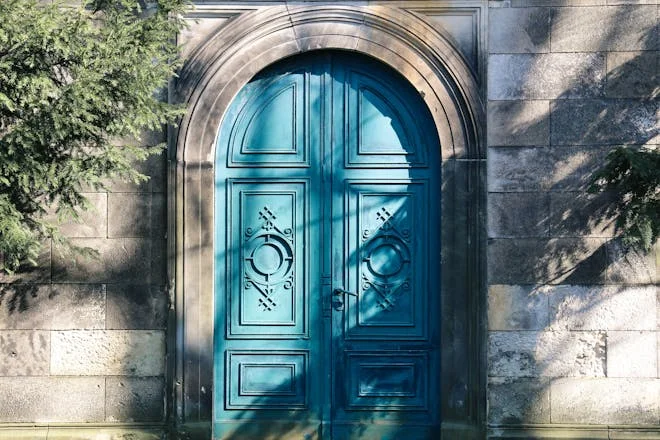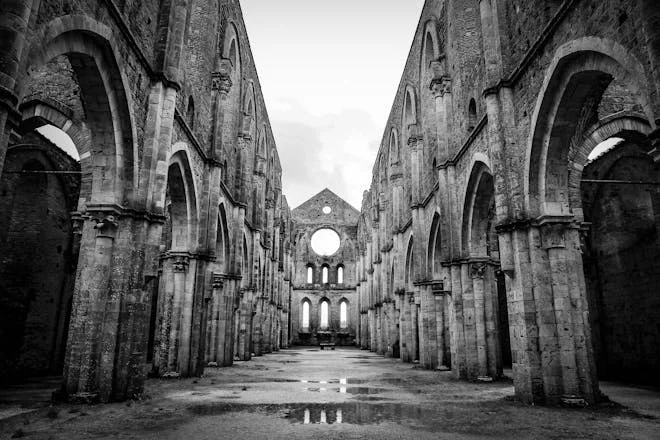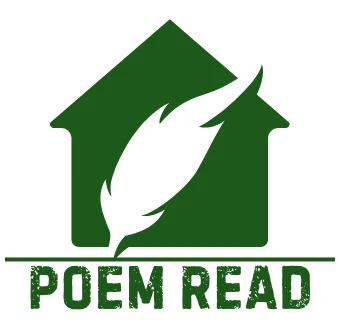
“The Listeners” by Walter de la Mare is a haunting and intriguing poem that explores themes of isolation, the supernatural, and the unknown. It tells the story of a lone traveler who arrives at a mysterious, deserted house and attempts to communicate with its ghostly inhabitants. Despite his persistent efforts, he receives no response, highlighting the barriers between the living and the dead.
This article aims to provide an in-depth analysis of the poem, covering its subject, context, theme, tone, form, and structure. We’ll also break down the poem line by line and discuss the literary devices used.
The Listeners
‘Is there anybody there?’ said the Traveller,
Knocking on the moonlit door;
And his horse in the silence champed the grasses
Of the forest’s ferny floor:
And a bird flew up out of the turret,
Above the Traveller’s head:
And he smote upon the door again a second time;
‘Is there anybody there?’ he said.
But no one descended to the Traveller;
No head from the leaf-fringed sill
Leaned over and looked into his grey eyes,
Where he stood perplexed and still.
But only a host of phantom listeners
That dwelt in the lone house then
Stood listening in the quiet of the moonlight
To that voice from the world of men:
Stood thronging the faint moonbeams on the dark stair,
That goes down to the empty hall,
Hearkening in an air stirred and shaken
By the lonely Traveller’s call.
And he felt in his heart their strangeness,
Their stillness answering his cry,
While his horse moved, cropping the dark turf,
’Neath the starred and leafy sky;
For he suddenly smote on the door, even
Louder, and lifted his head:—
‘Tell them I came, and no one answered,
That I kept my word,’ he said.
Never the least stir made the listeners,
Though every word he spake
Fell echoing through the shadowiness of the still house
From the one man left awake:
Ay, they heard his foot upon the stirrup,
And the sound of iron on stone,
And how the silence surged softly backward,
When the plunging hoofs were gone.
Content
- About the Author: Walter de la Mare
- Subject of "The Listeners"
- Context of "The Listeners"
- Theme and Tone of "The Listeners"
- Persona, Setting, and Narrative of “The Listeners”
- Form and Structure of "The Listeners"
- Line-by-Line Analysis of "The Listeners"
- Poetic and Literary Devices Used in "The Listeners"
- Implications and Meanings of "The Listeners"
- Interactive Summary
About the Author: Walter de la Mare
Walter de la Mare, born in 1873 in Charlton, Kent, England, was a prolific English poet, short story writer, and novelist. He is best known for his works that explore the supernatural and the mysterious. De la Mare’s writing often explores fantasy and the unknown, creating an eerie and dreamlike quality that captivates readers.
Throughout his career, de la Mare wrote extensively for both children and adults. His poetry collections, such as “The Listeners and Other Poems” published in 1912, highlight his ability to craft unconventional and memorable tales. He also received several literary honors, including the Order of Merit in 1953.
De la Mare’s fascination with the supernatural is evident in many of his works. He had a unique talent for blending reality with fantasy, making his stories and poems timeless. Throughout his career, de la Mare’s unique style and profound imagination earned him a lasting place in English literature, making his works lasting and intriguing.
Subject of “The Listeners”
“The Listeners” by Walter de la Mare centers around a lone traveler who arrives at an abandoned house in the middle of the night. The traveler knocks on the door, seeking a response, but is met with silence. Unbeknownst to him, ghostly listeners inhabit the house, hearing his calls but offering no reply. This creates eerie mystery and suspense.
The poem captures the traveler’s isolation and the mysterious presence of the unseen listeners. It explores themes of the supernatural and the unknown as the traveler attempts to communicate with them. The setting—a moonlit, deserted house—adds to the sense of mystery, reflecting the era’s fascination with ghost stories.
The poem’s subject extends beyond the traveler’s futile attempts to connect with the listeners; it delves into broader themes of communication between the living and the dead. It leaves readers with unease and curiosity, inviting contemplation of existence and the unknown.
Context of “The Listeners”
“The Listeners” by Walter de la Mare is placed within the context of early 20th-century literature, marked by a fascination with the supernatural and the mysterious. Written in 1912, the poem reflects an era captivated by spiritualism and the exploration of otherworldly realms. This period saw a surge in interest in ghost stories and tales of the paranormal, influenced by societal shifts and advancements in science and technology.
De la Mare’s poem taps into these cultural currents, presenting a narrative where a traveler encounters ghostly listeners in a secluded, moonlit house. The setting and atmosphere create a sense of unease and curiosity, typical of the Gothic tradition popular during that time. Furthermore, the poem explores communication between the living and the dead, resonating with contemporary debates and uncertainties about the afterlife and spiritual existence.
Overall, “The Listeners” emerges as a product of its literary and cultural context. It reflects themes and interests prevalent during the early 20th century, while inviting readers to contemplate timeless questions about the supernatural and human connection.
Theme and Tone of “The Listeners”
Theme
The primary theme of “The Listeners” is isolation. The traveler arrives at a desolate house seeking communication, but he receives no response. This theme reflects the human experience of reaching out for connection in an indifferent world. The traveler’s repeated calls and the silent house emphasize his solitude.
Another key theme is the supernatural. The listeners, described as “phantoms,” inhabit the house in an eerie, ghostly manner. They represent the unknown and the mysterious aspects of existence. This supernatural element adds depth to the poem, making it more than just a story about a lonely traveler.
The quest for understanding also permeates the poem. The traveler’s determination to keep his word and convey his message underscores the human desire for meaning and closure. Even though he leaves without a reply, his effort to communicate is significant. It reflects our universal need to be heard and to find purpose.
Overall, “The Listeners” explores deep and timeless themes through its haunting narrative. The poem captures the essence of human isolation, the mystery of the supernatural, and the persistent search for meaning in an unresponsive world.
Tone
The tone of “The Listeners” is mysterious and melancholic. From the start, the poem sets a somber mood with the traveler’s arrival at the moonlit, deserted house. The silence and stillness surrounding the scene create a sense of unease and anticipation.
Walter de la Mare uses descriptive language to enhance this tone. Phrases like “phantom listeners” and “quiet of the moonlight” evoke an eerie, ghostly atmosphere. The traveler’s unanswered knocks and calls add to the poem’s melancholic feel, highlighting his loneliness and the lack of response from the house’s inhabitants.
The tone also conveys a sense of resignation. Despite his efforts, the traveler does not receive a reply. His final words, “Tell them I came, and no one answered, / That I kept my word,” reflect a sense of acceptance. He acknowledges the silence and moves on, though with a lingering sadness.
Persona, Setting, and Narrative of “The Listeners”

Persona
In “The Listeners,” the primary persona is the unnamed traveler. He is depicted as a determined and persistent individual, seeking answers or fulfillment of a promise. His repeated knocking and questioning, “Is there anybody there?” highlights his desperation and resolve. The traveler’s character is universal, representing anyone who seeks understanding or connection in the face of silence and mystery. His actions and emotions drive the poem, making him a relatable figure for readers.
Setting
The setting of the poem is crucial to its eerie and mysterious atmosphere. The scene takes place at a deserted house in the middle of the night, illuminated only by moonlight. The house is described with vivid imagery, such as the “moonlit door” and the “leaf-fringed sill,” which create a haunting visual. The surrounding forest, with its “ferny floor” and “starred and leafy sky,” adds to the sense of isolation and abandonment. This setting enhances the poem’s themes of the unknown and the supernatural, making the traveler’s encounter even more unsettling.
Narrative
The narrative of “The Listeners” unfolds through the actions and experiences of the traveler. He arrives at the deserted house, knocks on the door, and repeatedly asks if anyone is there. Despite his efforts, he receives no response from the ghostly listeners inside. The poem’s narrative is linear, following the traveler’s journey from arrival to departure. The lack of a clear resolution or explanation adds to the poem’s suspense and mystery.
Form and Structure of “The Listeners”
“The Listeners” by Walter de la Mare is a single-stanza poem consisting of 36 lines. The poem is written in third person, which adds to the sense of detachment and mystery. Let’s break down its form and structure:
Stanza and Line Length
The poem is composed of one continuous stanza. This uninterrupted flow mirrors the traveler’s persistent yet unanswered calls. The lines vary in length, which helps to create a rhythmic and engaging reading experience. This variation also adds to the poem’s suspenseful tone.
Rhyme Scheme
The poem follows a consistent rhyme scheme of ABCB. This pattern contributes to the musical quality of the poem, making it more memorable and engaging. The rhyme scheme also enhances the eerie atmosphere, as the rhymes often fall on words that emphasize the poem’s mysterious and haunting themes.
Punctuation and Line Breaks
De la Mare uses punctuation sparingly but effectively. The poem includes commas, periods, and dashes, which help to control the pacing and build suspense. The line breaks are strategically placed to create pauses that enhance the poem’s tension and mystery. For example, the use of enjambment (continuing a sentence without a pause beyond the end of a line) keeps the reader moving forward, while caesura (a pause in the middle of a line) creates moments of reflection and suspense.
Rhythm and Meter
The poem does not adhere to a strict metrical pattern, which adds to its free-flowing and conversational tone. The rhythm varies throughout the poem, reflecting the traveler’s changing emotions and the eerie atmosphere of the setting. This irregular rhythm helps to maintain the reader’s interest and adds to the poem’s overall impact.
Consistency and Variation
While the poem maintains a consistent rhyme scheme, the variation in line length, punctuation, and rhythm keeps it dynamic and engaging. This balance between consistency and variation is key to the poem’s effectiveness, as it creates a sense of unpredictability that mirrors the traveler’s mysterious encounter.
Line-by-Line Analysis of “The Listeners”
Lines 1-2
“Is there anybody there?” said the Traveller,
Knocking on the moonlit door;
The poem opens with a question that immediately sets a mysterious tone. The traveler arrives at a house and knocks on the door, asking if anyone is there. The use of direct speech draws the reader into the scene, making them feel the traveler’s urgency and curiosity.
The capitalization of “Traveller” gives the character a sense of importance and universality, suggesting he could represent any person seeking answers. Additionally, the setting is bathed in moonlight, which adds an eerie and serene quality. The moonlit door symbolizes a threshold between the known world and the unknown.
Lines 3-4
And his horse in the silence champed the grasses
Of the forest’s ferny floor:
In the silence following his knock, the only sound is the traveler’s horse grazing on the forest floor. The description of “champing the grasses” emphasizes the stillness of the scene. The “ferny floor” of the forest creates a lush, almost magical environment, contrasting with the traveler’s anxious call.
Lines 5-6
And a bird flew up out of the turret,
Above the Traveller’s head:
A bird suddenly flying out of the turret introduces movement and sound, breaking the silence momentarily. This unexpected action highlights the traveler’s intrusion into a place that seems abandoned yet not entirely lifeless. The word “turret” suggests a castle-like structure, adding to the poem’s gothic and mysterious feel. This line also serves to break the silence momentarily, adding to the suspense.
Lines 7-8
And he smote upon the door again a second time;
“Is there anybody there?” he said.
The traveler knocks on the door again, this time with more force, repeating his question. This repetition also builds suspense, as the reader anticipates whether there will be a response. His insistence and the louder knock reflect his growing impatience and determination to get an answer.
Lines 9-12
But no one descended to the Traveller;
No head from the leaf-fringed sill
Leaned over and looked into his grey eyes,
Where he stood perplexed and still.
Despite his repeated attempts, no one comes to the door. The description of “no head from the leaf-fringed sill” paints a picture of the house’s exterior, adorned with leaves but devoid of life. This also adds a natural, almost overgrown element to the setting, suggesting neglect and abandonment.
Additionally, the lack of any head appearing reinforces the traveler’s solitude and the house’s eerie silence. The traveler’s “grey eyes” suggest wisdom or weariness, and his stillness indicates a mix of confusion and anticipation.
Lines 13-16
But only a host of phantom listeners
That dwelt in the lone house then
Stood listening in the quiet of the moonlight
To that voice from the world of men:
Through these lines, the poet reveals the presence of “phantom listeners” who inhabit the lonely house. These ghostly figures stand silently in the moonlight, listening intently to the traveler’s voice. The phrase “from the world of men” underscores the contrast between the living traveler and the spectral inhabitants. This revelation deepens the poem’s eerie and supernatural atmosphere, highlighting the unbridgeable gap between the living and the dead.
Lines 17-20
Stood thronging the faint moonbeams on the dark stair,
That goes down to the empty hall,
Hearkening in an air stirred and shaken
By the lonely Traveller’s call.
In these lines, the phantom listeners crowd the faint moonbeams on a dark staircase leading to an empty hall. This imagery creates a ghostly scene, enhancing the poem’s mysterious atmosphere. They listen intently, their silence making the air feel stirred and shaken by the traveler’s call. The “lonely Traveller’s call” emphasizes his isolation and the deep silence of the house. The listeners’ ghostly presence contrasts with the emptiness and stillness of the surroundings.
Lines 21-24
And he felt in his heart their strangeness,
Their stillness answering his cry,
While his horse moved, cropping the dark turf,
’Neath the starred and leafy sky;
Here, the traveler senses the strangeness of the phantom listeners. Their stillness feels like a silent reply to his call. Meanwhile, his horse continues to graze on the dark turf, providing a contrast to the traveler’s unsettling experience. The description of the night sky, filled with stars and leafy branches, enhances the scene’s natural beauty and juxtaposes with the supernatural silence of the house. This combination highlights the traveler’s isolation in a world that blends the familiar with the unknown.
Lines 25-28
For he suddenly smote on the door, even
Louder, and lifted his head:—
“Tell them I came, and no one answered,
That I kept my word,” he said.
In these lines, the traveler strikes the door even louder, showing his growing frustration and determination. He lifts his head and speaks firmly, instructing any possible listeners to relay his message. His words, “Tell them I came, and no one answered, / That I kept my word,” suggest a sense of duty or promise he needed to fulfill. This statement shows his commitment and the importance of his visit, even in the face of silence and mystery.
Lines 29-32
Never the least stir made the listeners,
Though every word he spake
Fell echoing through the shadowiness of the still house
From the one man left awake:
Here, the listeners remain completely motionless, showing no reaction to the traveler’s words. Despite their silence, every word he speaks echoes through the shadowy, quiet house. This highlights the haunting emptiness of the place. The phrase “the one man left awake” highlights the traveler’s solitude, emphasizing that he is alone and the only living being present in this mysterious and unsettling setting.
Lines 33-36
Ay, they heard his foot upon the stirrup,
And the sound of iron on stone,
And how the silence surged softly backward,
When the plunging hoofs were gone.
he ghostly listeners hear the traveler’s foot on the stirrup, indicating their awareness of his presence. The sound of iron on stone creates an auditory image, enhancing the poem’s sensory detail. As the traveler departs, the silence surges back, described almost as a physical entity. This movement of silence adds to the mysterious atmosphere.
The poem concludes with the sound of the horse’s hooves fading away, leaving the mystery unresolved. This ending maintains the haunting and suspenseful tone, emphasizing the traveler’s isolation and the ghostly listeners’ silent presence.
Poetic and Literary Devices Used in “The Listeners”

Imagery
Walter de la Mare employs vivid imagery throughout “The Listeners” to create a sense of mystery and solitude. For example, phrases like “moonlit door,” “forest’s ferny floor,” and “starred and leafy sky” paint detailed pictures that enhance the poem’s atmosphere. These images not only set the scene but also contribute to the overall mood, inviting readers to visualize the eerie setting and the actions of the characters.
Symbolism
Symbolism plays a crucial role in the poem, with elements such as the “phantom listeners” symbolizing the unseen or spiritual presence. The “moonlit door” symbolizes a threshold between the mundane and the mysterious worlds. Even the “lonely Traveller” symbolizes human persistence and existential questioning in the face of silence and mystery. These symbols deepen the poem’s meaning, allowing readers to interpret it beyond the literal narrative.
Personification
De la Mare uses personification to animate non-human elements, adding a mystical quality to the poem. For instance, the house is described as having “phantom listeners” and an atmosphere that responds to the traveler’s presence. This personification gives the house an almost sentient quality, heightening its role as a character in the narrative rather than just a setting.
Alliteration
The poet employs alliteration to create a melodic rhythm and emphasize certain sounds, enhancing the poem’s auditory experience. Lines like “faint moonbeams on the dark stair” and “sound of iron on stone” use repeated consonant sounds to draw attention to key moments in the poem. This technique not only adds musicality but also reinforces the eerie and haunting atmosphere of the poem.
Assonance
Assonance is the repetition of vowel sounds within words placed close to each other. In “The Listeners,” examples include “moonlit door” and “forest’s ferny floor.” These repeated vowel sounds create a musical effect and contribute to the poem’s lyrical quality.
Consonance
Consonance is the repetition of consonant sounds within words placed close to each other. An example from the poem is “sound of iron on stone.” The repeated “s” and “d” sounds evoke a sense of harshness or solidity, enhancing the description of the traveler’s actions.
Repetition
Repetition is used strategically to highlight themes and emotions throughout the poem. The repeated question, “Is there anybody there?” reflects the traveler’s increasing frustration and the persistent silence he encounters. This repetition emphasizes the central theme of isolation and unanswered questions, reinforcing the traveler’s emotional journey and the eerie ambiance of the house.
Enjambment
De la Mare utilizes enjambment to create a natural flow between lines and stanzas, enhancing the poem’s rhythm and pacing. For example, the lines “That dwelt in the lone house then / Stood listening in the quiet of the moonlight” flow seamlessly into each other, carrying the reader through the narrative without abrupt breaks. This technique contributes to the poem’s fluidity and allows for a smooth progression of ideas and imagery.
Caesura
Caesura, a pause within a line of poetry, is used to create dramatic effect and control the pacing. In “The Listeners,” caesura can be seen in lines like “And he felt in his heart their strangeness, / Their stillness answering his cry.” These pauses allow the reader to reflect on the traveler’s emotions and the eerie silence.
Rhyme
The poem follows an ABCB rhyme scheme, which contributes to its musical quality. This consistent pattern helps to unify the poem and makes it more memorable. The rhymes often fall on words that emphasize the poem’s themes of mystery and the supernatural.
Metaphor
Metaphors are sparingly used but effectively deployed to deepen the poem’s themes. For example, the “phantom listeners” can be interpreted metaphorically as symbolic representations of unanswered questions or unseen presences in life. This metaphorical layer adds depth to the narrative, inviting readers to contemplate broader existential and spiritual themes beyond the literal events described in the poem.
Onomatopoeia
Onomatopoeic words like “smote” and “plunging hoofs” create auditory imagery that enhances the reader’s sensory experience. These words mimic the sounds they describe, bringing the actions of the traveler and his surroundings to life in a vivid and evocative manner. The use of onomatopoeia enriches the poem’s descriptive quality, making it more immersive and engaging for the reader.
Irony
The poem employs irony through the contrast between the traveler’s persistent inquiries and the ghostly listeners’ silent response. Despite his repeated efforts to communicate, the traveler is met with complete silence from the spectral inhabitants of the house. This irony underscores the theme of existential loneliness and the human desire for connection, highlighting the disconnect between the living and the unseen world.
Oxymoron
An oxymoron is a literary device that pairs contradictory terms to create a paradoxical effect. Although not explicitly stated in “The Listeners,” the contrast between the living traveler and the spectral listeners can be viewed as a conceptual oxymoron. This contrast emphasizes how the tangible presence of the traveler interacts with the intangible presence of the listeners. It highlights their coexistence in the poem’s narrative.
Allegory
An allegory is a narrative that carries symbolic meanings beyond its literal storyline. In “The Listeners,” which primarily tells the tale of a traveler encountering ghostly listeners, the house and its ghostly inhabitants can be seen as symbols. They might represent human desires, questions about existence, or the search for meaning during times of silence and isolation. This allegorical aspect adds depth to the poem, encouraging readers to explore deeper philosophical and emotional layers beyond its surface story.
Implications and Meanings of “The Listeners”
“The Listeners” by Walter de la Mare explores themes like isolation, the supernatural, and the mysteries of life and death. Here’s a breakdown:
Communication and Isolation
The poem portrays the traveler’s struggle to connect with ghostly listeners, symbolizing a barrier between the living and the dead. His unanswered calls highlight the difficulty of bridging this gap, reflecting themes of loneliness and the human quest for understanding.
The Unknown and the Supernatural
Through its eerie setting and ghostly characters, the poem invites readers to ponder unseen realms and the mysteries they hold. This exploration challenges us to think about supernatural forces and what lies beyond our everyday understanding.
The Human Experience
“The Listeners” reflects the universal desire for meaning and connection. The traveler’s journey mirrors our own search for answers amidst uncertainty, emphasizing the importance of communication even in silence.
The Power of Silence
Silence in the poem creates a haunting atmosphere, emphasizing the limits of human perception and the mysteries that remain unsolved. It prompts us to consider the significance of unanswered questions and the complexities of communication.
Reflection on Mortality
The poem prompts us to think about life and death. The encounter between the traveler and ghostly listeners raises questions about what happens after we die and the nature of consciousness beyond life. It encourages us to reflect on our beliefs about mortality and the unknown.
In summary, “The Listeners” by Walter de la Mare is a thought-provoking exploration of isolation, the supernatural, and human introspection. Its themes and imagery encourage us to contemplate life’s mysteries and the boundaries between the known and the unknown.
Interactive Summary

“The Listeners” by Walter de la Mare is a haunting poem that explores themes of isolation, the unknown, and the supernatural. It tells the story of a lone traveler who arrives at a deserted, moonlit house and tries to communicate with its ghostly inhabitants. Despite his repeated attempts, he receives no response, highlighting the barriers between the living and the dead.
Consequently, the poem prompts us to think about communication and our desire for connection. It creates a mysterious atmosphere with vivid imagery and a consistent rhyme scheme, inviting us to consider unseen worlds and their secrets. Furthermore, the traveler’s isolation and the silent presence of the ghostly listeners create a sense of mystery and suspense.
Additionally, using symbols and imagery, “The Listeners” encourages us to ask deeper questions about life, death, and what comes after. It shows how silence can be powerful and leads us to reflect on our beliefs and thoughts.
Overall, “The Listeners” is a captivating poem that explores loneliness, the supernatural, and the complexities of being human. It invites readers to delve into profound themes and reflect on the mysteries of existence.
If you enjoyed analyzing “The Listeners,” you might also be interested in our detailed analysis of Robert Frost’s “Stopping by Woods on a Snowy Evening,” which explores similar themes of solitude and reflection.
RELATED POSTS
View all



